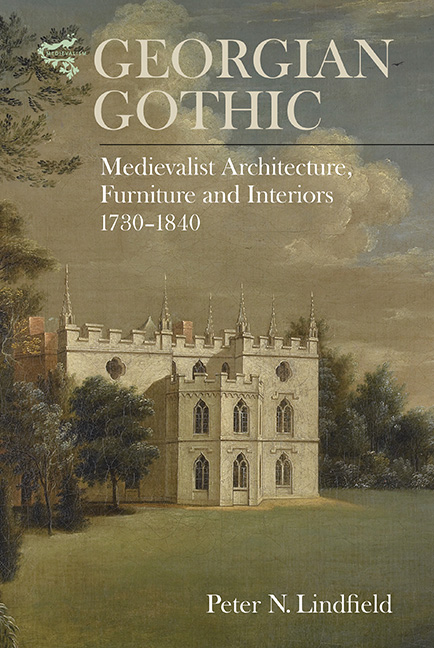Book contents
- Frontmatter
- Dedication
- Miscellaneous Frontmatter
- Contents
- List of Illustrations
- Acknowledgements
- Introduction: the Gothic Aesthetic in Britain and British Furniture, 1730–1840
- 1. Understanding Gothic Architecture in Georgian Britain
- 2. Creation of Classical Gothic Architecture, Furniture and Interiors
- 3. High Fashion and Fragments of the Past: the Omnipresence of Rococo Gothic
- 4. Fluctuating Tastes: Gothic in Later Eighteenth-century Britain
- 5. The ‘Chaos of Modern Gothic Excrescences’: Regency to Revolution
- Conclusion
- Appendix
- Bibliography
- Glossary
- Index
- Miscellaneous Endmatter
4. - Fluctuating Tastes: Gothic in Later Eighteenth-century Britain
Published online by Cambridge University Press: 25 October 2017
- Frontmatter
- Dedication
- Miscellaneous Frontmatter
- Contents
- List of Illustrations
- Acknowledgements
- Introduction: the Gothic Aesthetic in Britain and British Furniture, 1730–1840
- 1. Understanding Gothic Architecture in Georgian Britain
- 2. Creation of Classical Gothic Architecture, Furniture and Interiors
- 3. High Fashion and Fragments of the Past: the Omnipresence of Rococo Gothic
- 4. Fluctuating Tastes: Gothic in Later Eighteenth-century Britain
- 5. The ‘Chaos of Modern Gothic Excrescences’: Regency to Revolution
- Conclusion
- Appendix
- Bibliography
- Glossary
- Index
- Miscellaneous Endmatter
Summary
The Taste which now reigns is that of the Antique. Everything we now use, is made in imitation of those models which have been lately discovered in Italy; and they serve in the same manner to occupy our imagination, by leading to those recollections of Grecian or Roman Taste, which have so much the possession of our minds, from the studies and amusements of our youth.
(Archibald Alison, 1790)AFTER C.1765 FASHIONABLE applied design followed Classical ideals. This new form of Classicism, later termed Neoclassicism, was promoted by, amongst others, a new wave of leading London-based architects. Of these, Robert Adam (1728–92) and James Wyatt (1746–1813) created some of the most noteworthy and lavish Neoclassical buildings furnished in a sympathetic, Classical manner. Exemplary of the unified application of Classical design is Adam's remodelling of Osterley Park, Middlesex (1763–80), and the furniture he designed for its interior, including the domed state bed (1776–78). The overwhelming predominance of the Neoclassical style is ably demonstrated by Adam's and Wyatt's country house architecture: 93.9 per cent and 89.2 per cent respectively is Classical. Cabinet-makers, including John Linnell (1729–96) and Thomas Chippendale (c.1718–79), similarly adopted the new style in favour of the then receding taste for the Rococo, and the most expensive seat furniture ever produced by Chippendale – a suite of chairs and sofas designed by Adam in 1764 for Sir Lawrence Dundas’ town house, 19 Arlington Street, London – embraced this new design language wholeheartedly. Neoclassi cism cannot, however, be detected to any notable degree in Chippendale's Director (1762) or Ince's and Mayhew's Universal System (1762); these pattern-books, instead, concentrate upon Rococo furniture. Lock's New Book of Pier Frames, the first eighteenth-century furniture pattern-book to promote Neoclassical interior design, was not published until 1769. Lagging somewhat behind the change in fashions, the most substantial of Neoclassical furniture pattern-books were not published until later in the century, the leading examples being George Hepplewhite's The Cabinet-Maker & Upholsterer's Guide (1788, 1789, 1794) and Thomas Sheraton's The Cabinet-Maker and Upholsterer's Drawing-Book (1792, 1794).
- Type
- Chapter
- Information
- Georgian GothicMedievalist Architecture, Furniture and Interiors, 1730-1840, pp. 131 - 179Publisher: Boydell & BrewerPrint publication year: 2016

